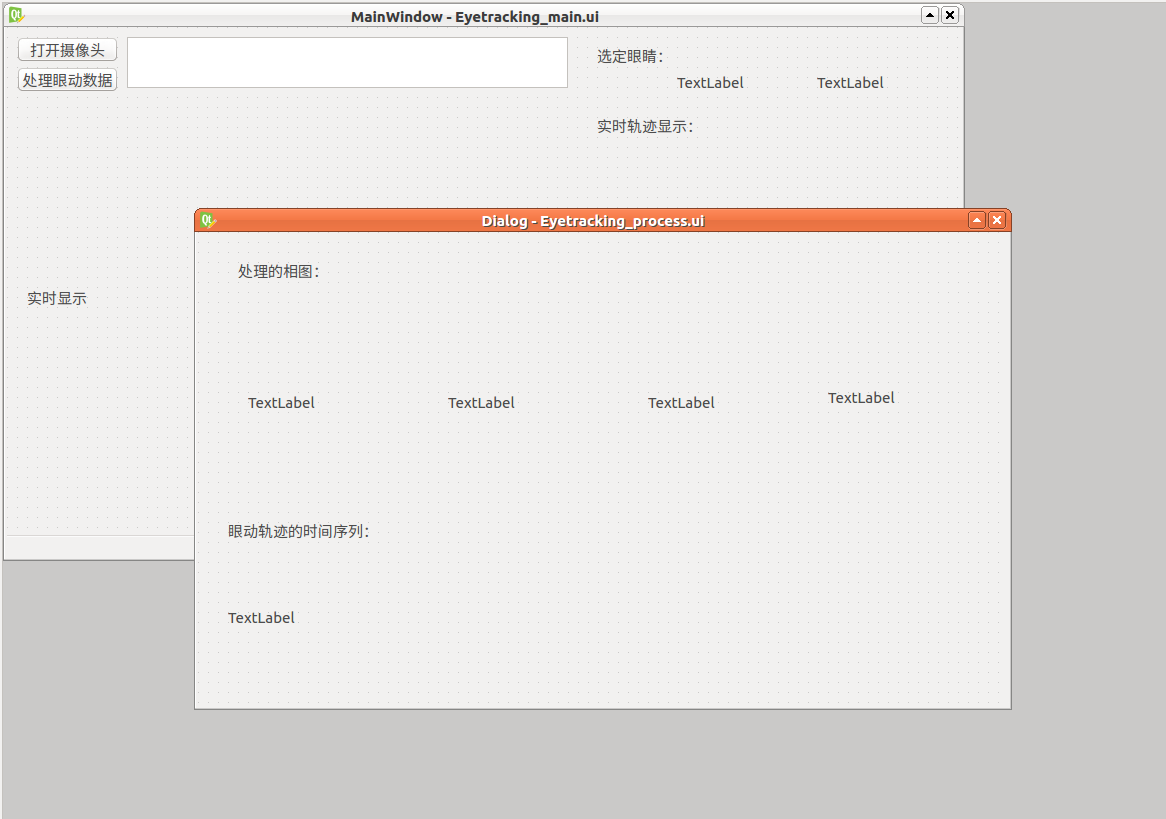Python 中PyQt5 点击主窗口弹出另一个窗口的实现方法
2019-07-04 11:32
1126 查看
1.先使用Qt designer设计两个窗口,一个是主窗口,一个是子窗口

|
其中主窗口是新建-Main Window,子窗口是Dialog窗体。
两个窗口不能是同一类型,否则会崩溃。
并保存为EyeTracking_main.ui和EyeTracking_process.ui(因为我在做眼动追踪,因此窗体命名与此相关,后同),使用UIC工具转成.py文件。
2.写一个驱动函数调用两个窗体
主窗体Eyetracking_main.py
from PyQt5 import QtCore, QtGui, QtWidgets
class Ui_MainWindow(object):
def setupUi(self, MainWindow):
MainWindow.setObjectName("MainWindow")
MainWindow.resize(954, 530)
self.centralwidget = QtWidgets.QWidget(MainWindow)
self.centralwidget.setObjectName("centralwidget")
self.toolButton = QtWidgets.QToolButton(self.centralwidget)
self.toolButton.setGeometry(QtCore.QRect(10, 40, 101, 25)) self.toolButton.setObjectName("toolButton")
...1234567891011
子窗体Eyetracking_process.py
from PyQt5 import QtCore, QtGui, QtWidgets
class Ui_Dialog(object):
def setupUi(self, Dialog):
Dialog.setObjectName("Dialog")
Dialog.resize(810, 474)
self.label_5 = QtWidgets.QLabel(Dialog)
self.label_5.setGeometry(QtCore.QRect(630, 90, 151, 151))
self.label_5.setObjectName("label_5")
self.label_2 = QtWidgets.QLabel(Dialog)
self.label_2.setGeometry(QtCore.QRect(250, 90, 171, 161))
self.label_2.setObjectName
("label_2")
...12345678910111213
将驱动函数命名为EyeTracking_ui.py
from Eyetracking_main import * from Eyetracking_process import * from PyQt5.QtWidgets import QApplication,QMainWindow,QDialog import sys class parentWindow(QMainWindow): def __init__(self): QMainWindow.__init__(self) self.main_ui = Ui_MainWindow() self.main_ui.setupUi(self) class childWindow(QDialog): def __init__(self): QDialog.__init__(self) self.child=Ui_Dialog() self.child.setupUi(self) if __name__=='__main__': app=QApplication(sys.argv)window=parentWindow() child=childWindow() #通过toolButton将两个窗体关联btn=window.main_ui.toolButton btn.clicked.connect(child.show) # 显示 window.show() sys.exit(app.exec_())
因为后续还要在各个窗体操作,因此将主窗口与子窗口各自实例化在parentWindow和childWindow两个类中,这两个类各自继承了QMainWindow和QDialog的父类:
class parentWindow(QMainWindow): def __init__(self): QMainWindow.__init__(self)#QMainWindow的初始化 self.main_ui = Ui_MainWindow()#主窗口的实例化 self.main_ui.setupUi(self) class childWindow(QDialog): def __init__(self): QDialog.__init__(self) self.child=Ui_Dialog()#子窗口的实例化 self.child.setupUi(self)
后面分别再把两个窗口实例化给window和child:
window=parentWindow() child=childWindow()
通过定义按钮意义将两个窗体关联起来:
btn=window.main_ui.toolButton btn.clicked.connect(child.show)
表示当按钮按下时,子窗口显示。
如下图,当点击“处理眼动数据”,弹出处理处理窗体:

总结
以上所述是小编给大家介绍的Python 中PyQt5 点击主窗口弹出另一个窗口的实现方法,希望对大家有所帮助,如果大家有任何疑问请给我留言,小编会及时回复大家的。在此也非常感谢大家对脚本之家网站的支持!
如果你觉得本文对你有帮助,欢迎转载,烦请注明出处,谢谢!
您可能感兴趣的文章:
相关文章推荐
- python3 tkinter实现点击一个按钮跳出另一个窗口的方法
- 弹出窗口,点击确定在删除数据的实现方法
- python 中pyqt5 树节点点击实现多窗口切换问题
- 弹出窗口,点击确定在删除数据的实现方法
- javascript实现点击按钮弹出一个可关闭层窗口同时网页背景变灰的方法
- javascript实现点击按钮弹出一个可关闭层窗口同时网页背景变灰的方法
- Asp.net实现弹出窗口提示,又防止刷新被重复提交的方法
- 点击弹出窗口网页背景变暗且不可点的效果(一):div实现
- jQuery实现选中弹出窗口选择框内容后赋值给文本框的方法
- 基于cppunit的bcb中,运行某测试用例时,弹出窗口的实现方法
- Asp.net实现弹出窗口提示,又防止刷新被重复提交的方法
- JavaScript实现自动弹出窗口并自动关闭窗口的方法
- 点击链接后,弹出另一个浮动窗口,全屏变暗遮罩效果,适用于下载站
- 两种方法实现点击窗口任意位置的拖拽
- 点击弹出层效果&弹出窗口后网页背景变暗效果的实现代码
- js实现点击链接后窗口缩小并居中的方法
- JavaScript实现点击文字切换登录窗口的方法
- jquery 触发a标签点击事件,弹出页面;不被浏览器屏蔽拦截的打开窗口的方法
- Joomla实现组件中弹出一个模式(modal)窗口的方法
- 2006.9.21 MSN类型得弹出窗口的实现方法
